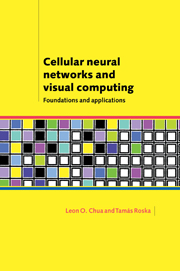Book contents
- Frontmatter
- Contents
- Acknowledgements
- 1 Introduction
- 2 Notation, definitions, and mathematical foundation
- 3 Characteristics and analysis of simple CNN templates
- 4 Simulation of the CNN dynamics
- 5 Binary CNN characterization via Boolean functions
- 6 Uncoupled CNNs: unified theory and applications
- 7 Introduction to the CNN Universal Machine
- 8 Back to basics: Nonlinear dynamics and complete stability
- 9 The CNN Universal Machine (CNN-UM)
- 10 Template design tools
- 11 CNNs for linear image processing
- 12 Coupled CNN with linear synaptic weights
- 13 Uncoupled standard CNNs with nonlinear synaptic weights
- 14 Standard CNNs with delayed synaptic weights and motion analysis
- 15 Visual microprocessors – analog and digital VLSI implementation of the CNN Universal Machine
- 16 CNN models in the visual pathway and the “Bionic Eye”
- Notes
- Bibliography
- Exercises
- Appendices
- Index
1 - Introduction
Published online by Cambridge University Press: 28 May 2010
- Frontmatter
- Contents
- Acknowledgements
- 1 Introduction
- 2 Notation, definitions, and mathematical foundation
- 3 Characteristics and analysis of simple CNN templates
- 4 Simulation of the CNN dynamics
- 5 Binary CNN characterization via Boolean functions
- 6 Uncoupled CNNs: unified theory and applications
- 7 Introduction to the CNN Universal Machine
- 8 Back to basics: Nonlinear dynamics and complete stability
- 9 The CNN Universal Machine (CNN-UM)
- 10 Template design tools
- 11 CNNs for linear image processing
- 12 Coupled CNN with linear synaptic weights
- 13 Uncoupled standard CNNs with nonlinear synaptic weights
- 14 Standard CNNs with delayed synaptic weights and motion analysis
- 15 Visual microprocessors – analog and digital VLSI implementation of the CNN Universal Machine
- 16 CNN models in the visual pathway and the “Bionic Eye”
- Notes
- Bibliography
- Exercises
- Appendices
- Index
Summary
Scenario
Recent history of the electronic and computer industry can be viewed as three waves of revolutionary processes. The first revolution, making cheap computing power available via microprocessors in the 1970s, led to the PC industry of the 1980s. The cheap laser and fiber optics, which resulted in cheap bandwidth at the end of the 1980s, led to the Internet industry of the 1990s. The third wave, the sensor revolution at the end of the 1990s, will also provide for a new industry. Sensor revolution means that cheap sensor and MEMS (micro-electro-mechanical system) arrays are proliferating in almost all the conceivable forms. Artificial eyes, nose, ears, taste, and somatosensory devices as well as sensing all physical, chemical, and biological parameters, together with microactuators, etc. are becoming commodities. Thousands and millions of generically analog signals are produced waiting for processing. A new computing paradigm is needed. The cited technology assessment reads:
The long-term consequence of the coming sensor revolution may be the emergence of a newer analog computing industry in which digital technology plays a mere supporting role, or in some instances plays no role at all.
For processing analog array signals, the revolutionary Analogic Cellular Computer paradigm is a major candidate. The core of this computer is a Cellular Nonlinear/neural network (CNN), an array of analog dynamic processors or cells. The computer architecture is the CNN Universal Machine, with its various physical implementations. At the same time, Analogic CNN computers mimic the anatomy and physiology of many sensory and processing organs with an additional capability of stored programmability.
- Type
- Chapter
- Information
- Cellular Neural Networks and Visual ComputingFoundations and Applications, pp. 1 - 6Publisher: Cambridge University PressPrint publication year: 2002



